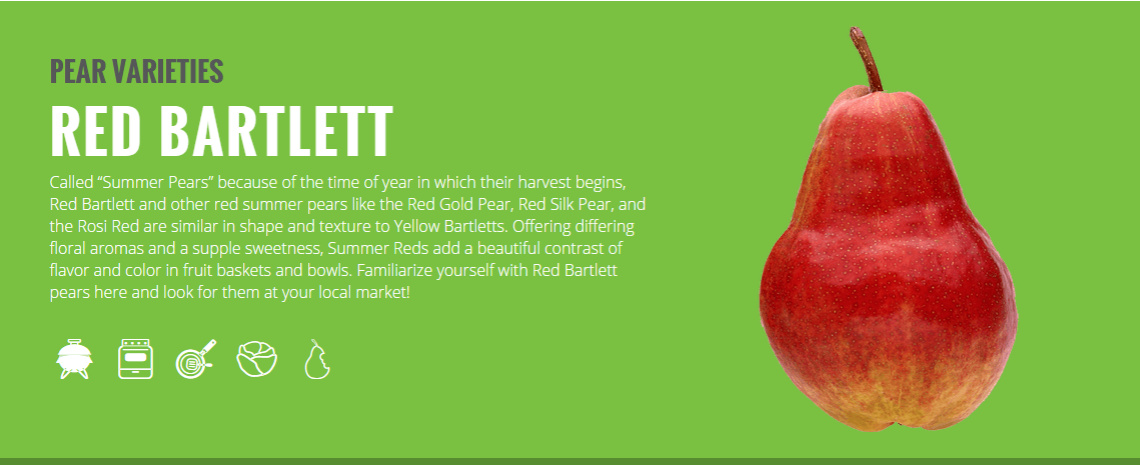IDENTIFYING RED BARTLETT
The Red Bartlett pear carries a true pyriform “pear shape;” a rounded bell on the bottom half of the fruit, then a definitive shoulder with a smaller neck or stem end. Just as Yellow Bartletts change color while ripening, so do Red Bartletts; changing from a dark red often with light vertical striping to become a beautiful bright red. As they ripen, Red Bartletts offer differing flavors and textures, starting crunchy and tart when underripe, and finishing super sweet and juicy when fully ripened.
SEASONALITY
Like their yellow counterparts, Red Bartletts are among the first pears ready for harvest each season. Hand-picked like all USA Pears, harvest for Red Bartletts runs late August to early September and they remain available in markets through January. Gentle harvesting methods and modern packing facilities in the Northwest ensure a quality selection when fruit arrives in grocery produce departments.
Northwest Bartletts are harvested when fully mature, but before they become ripe. Pears are a unique fruit; if allowed to ripen on the tree, natural deposits of lignin and cellulose will develop in the flesh, causing a “gritty” texture. Northwest Pears are harvested when mature and then allowed to ripen, so you can expect a smoother texture with sweeter flavor.
RIPENING
Like the Yellow Bartlett pear, the Red Bartlett is a likewise unique pear in that its skin color brightens as it ripens, while other varieties of pears show little color change as they ripen. The Yellow Bartlett’s skin transforms from green to yellow as it ripens, and the Red Bartlett ripens from a dark red to a brilliant red as it becomes sweeter and juicier during the ripening process. Remember, all pears ripen at room temperature! Only refrigerate your pears if you want to slow the ripening process.
A CANNING TRADITION
Red and Yellow Bartletts are a prized fruit for canning, and you’ll find several suggestions in the recipes listed on this page. The bright red color of Red Bartletts is only skin deep, so it will make no difference in preserving recipes whether you use Yellow or Red Bartletts because you will peel them. Both Yellow and Red Bartletts have a definitive flavor and sweetness, making them the best all-around choice for canning.
CULINARY USES
Red Bartletts offer much the same great flavors as Yellow Bartletts, but their color simply adds to their appeal! Consider sliced red pears to liven up green salads or other recipes. Always remember that any recipe calling for apples can be made using fresh pears. Check out our pear-tastic recipes!
THE HISTORY OF THE RED BARTLETT
The Red Bartlett, known also as ‘Max Red’, was first discovered as a bud sport on a standard Yellow Bartlett tree near Zillah, Washington in 1938. A “bud sport” is a rare, naturally occurring transformation that develops spontaneously on fruit trees. The Red Bartlett pear was then cultivated by pear growers, resulting in the large crop we enjoy today.
